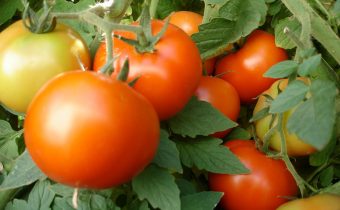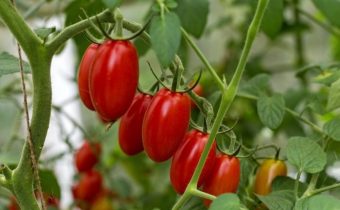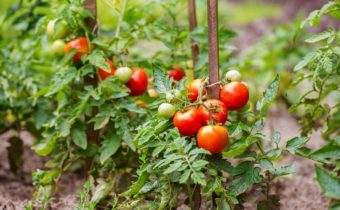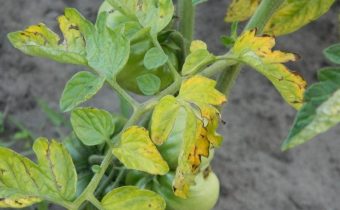Tomatoes in the greenhouse will help to save these methods from withering
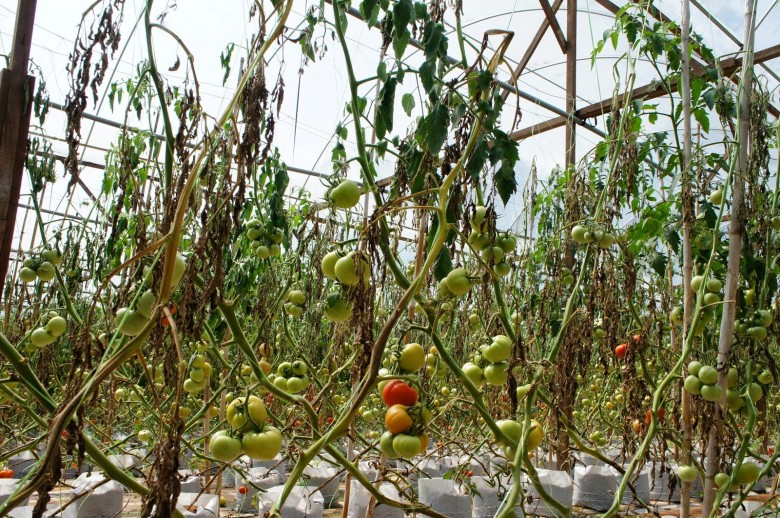
Often in the greenhouse you can witness the withering of tomato leaves. The appearance of an unpleasant illness can be caused by illnesses, poor lighting, lack of food and moisture. To save tomatoes from death and preserve the crop can be, applying preventive and therapeutic measures.
Diseases leading to leaf wilt
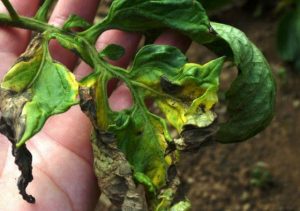 One of the most dangerous fungal diseases of tomatoes, causing wilting of greenery - Fusarium, which is transmitted through potatoes. The first symptoms of spreading are manifested in the defeat of the lower leaves - they wither and turn yellow. Soon whole shoots, flowers, fruits begin to wither. An accumulation of conidia can be observed in the areola of the root collar: a pinkish-whitish patina appears on this site. The spores of the fungus wander through the vessels of the plant, gradually covering it entirely.
One of the most dangerous fungal diseases of tomatoes, causing wilting of greenery - Fusarium, which is transmitted through potatoes. The first symptoms of spreading are manifested in the defeat of the lower leaves - they wither and turn yellow. Soon whole shoots, flowers, fruits begin to wither. An accumulation of conidia can be observed in the areola of the root collar: a pinkish-whitish patina appears on this site. The spores of the fungus wander through the vessels of the plant, gradually covering it entirely.
The fact is that the fungus can live in the ground for many years, waiting for the shares of tomatoes. As soon as the young seedlings enter the soil and a favorable situation occurs (high humidity, excess nitrogen, temperature above 27 degrees), the fungus immediately activates, penetrating first into the roots, and then spreading throughout the body of the tomato bush.
Fusarium in greenhouses is ubiquitous, as the greenhouse climate is ideal for the propagation of fungi.
For other fungal diseases that cause wilting of foliage include blight, verticillis, sclerotinia. Pathogens act in the same way as with fusarium - penetrating inside the stem, fungi spread throughout all organs, affecting them one by one. As a result, foliage, branches, flowers and fruits wither.
Viral infections affecting the leaves include internal leaf necrosis, strick, mosaic. Bacterial - bacterial cancer, black spot.
Treatment
Fungal diseases can be cured at the initial stage of their appearance, or, at least, to slow down the development of the disease until the harvest is fully formed.
Since weakened plants are the first to be affected, it is important that during the growing of seedlings to be fed with trace elements to increase the immunity of seedlings. When the first signs of the disease appear, it is necessary to immediately remove the affected areas from the bushes and begin systematic treatment of the beds (once every two weeks) with ziebom, 0.5% solution of copper oxychloride or bordeaux liquid. Or use chemical fungicides, such as Fitosporin, Hom and others.
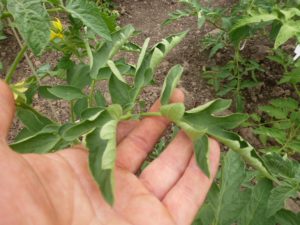 Infections caused by bacteria and viruses are for the most part not treatable. You can fight them before they appear, using preventive measures. To do this, when sowing, seeds are pickled in a manganese solution. During the growth of seedlings, it is fed with microelements. Adult plants are fed with potash fertilizers, sprayed with a solution of potassium permanganate.
Infections caused by bacteria and viruses are for the most part not treatable. You can fight them before they appear, using preventive measures. To do this, when sowing, seeds are pickled in a manganese solution. During the growth of seedlings, it is fed with microelements. Adult plants are fed with potash fertilizers, sprayed with a solution of potassium permanganate.
Since many diseases of the protected soil appear at elevated temperatures and excessive humidity, the treatment of tomatoes comes down to regular airing of the greenhouse space, disinfecting the soil, reducing irrigation and controlling the temperature within medium limits.
Do not waste precious time rescuing diseased plants - all efforts will be in vain.Switch attention to healthy bushes and do everything so that the infection does not affect them. To do this, as soon as possible, remove diseased tomatoes from the site, and disinfect the ground under them with copper sulphate, so that the pathogen does not spread to the remaining plants.
Insect infestation
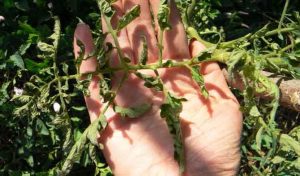 Often the impact of pests causes wilting of leaves on tomato bushes. To determine which insect attacked the tomatoes and effectively get rid of it, will help a thorough examination of the underside of the leaves.
Often the impact of pests causes wilting of leaves on tomato bushes. To determine which insect attacked the tomatoes and effectively get rid of it, will help a thorough examination of the underside of the leaves.
- Aphid is localized in the folds of plants. It sucks the juice from the leaves, thereby causing them to wither and die. Get rid of it will help the repeated treatment of insecticide beds.
- Whitefly larvae gather on the leaves in order to eat them. Waste from their vital activity leads to the appearance of fungal diseases. The problem is that the whitefly is immune to serious poisons and has the ability to get used to chemical insecticides.
- The occurrence of a spider mite on the bushes also leads to drying of the foliage. It focuses on lower foliage, affecting the entire plant in a couple of weeks. To destroy it will require strong chemicals.
Unsuitable Tomato Conditions
Drying and yellowing of leaves can cause improper care of the tomatoes. Most often, the problem is solved after changes in growing conditions of tomatoes.
Wrong watering
When growing tomatoes in protected ground, it is important to prevent excessive humidity of the air and soil, since it is an excess of moisture that leads to the appearance of rot, disease-causing mycelium, which leads to wilting of the foliage and the death of plants. The lack of water also leads to plant dysfunction, which also leads to the shrinkage of the green part. Observe a middle ground in irrigation - the key to healthy growth of tomato bushes.
Watering rules: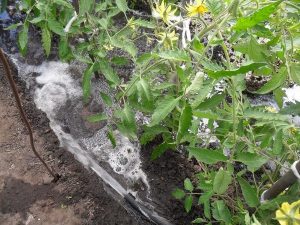
- Young seedlings watered every day a little bit. The earth must remain semi-humid. Water the saplings in the early morning so that before the onset of the heat the moisture is completely absorbed by the plant.
- Until flowering tomatoes watered every 3-4 times in small portions.
- Fruiting bushes are watered rarely, but very abundant. Frequent watering can affect the quality of the fruit - they will crack. It is optimal to arrange water procedures once every 6 days with moderate summer and twice a week - with wet and cool. The main landmark for the commission of irrigation - dried up soil.
- Water the tomatoes at room temperature and just under the root. Ideal for drip irrigation in the greenhouse.
- After the procedure, the greenhouse is thoroughly ventilated so that condensate does not accumulate on the leaves of the plants. And it will be good if the greenhouse will be equipped with windows along the entire height of the wall. So ventilation will be performed throughout the greenhouse.
Light and poor ventilation
For the harmonious development of tomato plants they need a lot of sunlight. If it is not enough, then the humidity rises immediately, condensation forms, diseases develop. At the same time, the stalks of the plants become thinner, strongly drawn out. Such bushes grow weakly, the foliage fades, turns yellow, and falls. Flowering does not occur. And although the greenhouse from polycarbonate well passes the sun's rays, sometimes the ultraviolet does not reach the plants, in particular, their specific parts, due to the thickening of the landings. Either the greenhouse is installed in the wrong part of the site, and the sun hits the plants only for a short time. In any case, without light, the bushes of tomatoes will not grow. Therefore, if there is a shortage of sun (for example, in winter or regions with a short daylight hours), then additional lighting should be installed in the greenhouse using low-power fluorescent lamps that will illuminate the tomatoes for at least 14 hours a day.
For better lighting, we recommend laying out white paper or reflective elements on the floor.
Plants dry out due to overheating
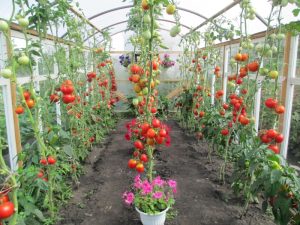 In summer, the air in the greenhouse heats up very quickly to unimaginable values. Excessive heat affects the well-being of the tomato bush. Overheating, the leaves dry, fade, turn yellow and fall off. The plant is struggling with this state, expending all the power to support life at the expense of flowering and fruit formation. The longer the tomatoes are in the heat, the harder it will be to help them. However, even if you throw all the power to restore the vital functions of the body of plants, in the future they will not be able to give a bountiful harvest.
In summer, the air in the greenhouse heats up very quickly to unimaginable values. Excessive heat affects the well-being of the tomato bush. Overheating, the leaves dry, fade, turn yellow and fall off. The plant is struggling with this state, expending all the power to support life at the expense of flowering and fruit formation. The longer the tomatoes are in the heat, the harder it will be to help them. However, even if you throw all the power to restore the vital functions of the body of plants, in the future they will not be able to give a bountiful harvest.
The fact is that in the heat the pollen becomes sterile, it will not be able to participate in fertilization. Accordingly, the fruit will not be set, the crop will be lost.
The optimum temperature of a polycarbonate greenhouse should be 23-25 degrees during the day and at least 16 at night. You can control the temperature with the help of airing or installed barrels of cold water, which will take some of the heat on yourself. It will not be superfluous to cover the roof with a dark pace to prevent burns on the foliage.
Nutrient Shortage
The lack or excess of vitamins and microelements in the ground also leads to shrinkage and wilting of the foliage, death of flowers, and poor fruiting. Excess nitrogen leads to fattening of tomatoes, the lack of - to the loss of healthy-looking leaves. With an insufficient dose of potassium in the soil foliage and buds dry and fall off. There is a withering of the leaves and with a small amount of magnesium.
In order to avoid problems with nutritional starvation, it is necessary to conduct regular fertilizing with complex fertilizers. The most optimal fertilizer should contain 10 parts of nitrogen, 5 parts of phosphorus and 20 parts of potassium. These are the basic elements for the growth and development of tomatoes. Also, the fertilizer should include trace elements - calcium, boron, magnesium, sulfur and others. There are many types of fertilizers. “Mortar”, “Crop”, “For Tomatoes” and others are among the best.
Prevention
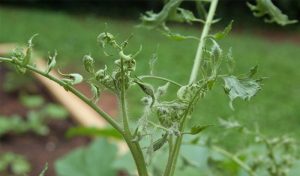 To avoid wilting of foliage, you can use simple rules for growing tomatoes:
To avoid wilting of foliage, you can use simple rules for growing tomatoes:
- Observe crop rotation. Preventing the development of many diseases can be avoided by planting tomatoes each year in a new place. Returning to the old can be at least 3-4 years, just so much fungus is needed to become not dangerous. Do not plant tomatoes after potatoes and other solanaceous crops, as they have common diseases.
- If the greenhouse has a small size, then it will have to be moved every year to another place or completely replaced the soil in it.
- Before planting seedlings disinfect the greenhouse soil with copper sulphate.
The annual sterilization of the frame and walls of the greenhouse will not interfere either.
- For better illumination and ventilation of the bushes, plant no more than 4 seedlings per square meter. Remove the lower leaves so that they do not create a shadow and do not create a poor absorption of moisture by the earth.
- As a preventive measure, fertilize the tomatoes with the organic drug “Effecton-O”.
- Spray tomato antimicrobials regularly. The best fungicides include such agents: Kvadris, Home, Ridomil, Agat, Fundazol, Maxim, Ordan.
- Many diseases occur with an excess of nitrogen in the soil. Do not use fresh manure to fertilize tomatoes - it adversely affects their health.
- For the full development of tomato bushes regularly make root and foliar feeding, containing a number of necessary mineral elements.
- To build new root shoots and strengthen plants, roll up tomatoes. The root neck should remain under the ground for at least 15 centimeters.
- After harvesting, remove all plant residues from the ground. The earth is worth digging and sanitizing.
Conclusion
As you can see, tomato leaves fade for various reasons. Most of them are associated with the depressed state of the plants, the conduct of improper agricultural practices. The appearance of disease is, above all, a consequence of poor care.Save the harvest can only be competent and reasonable treatment of the crop.


